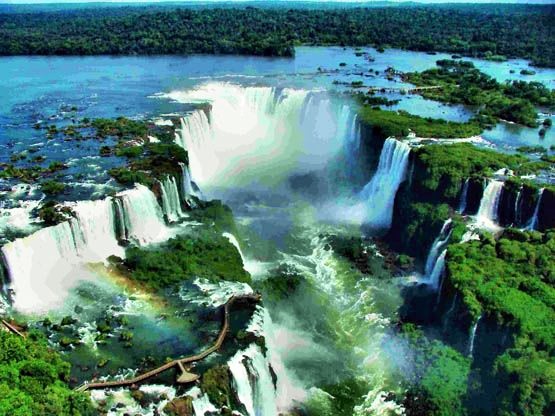Inga Falls, Congo River, Africa
Regularly it is reported that the biggest waterfall of the world is Inga Falls in the Democratic Republic of the Congo. This is not by any stretch of the imagination genuine - Inga Falls is not a genuine waterfall, these are rapids falling per 96 m over the separation of 15 km.
By and by this is an exceptional characteristic point of interest.
Giant rapids
Falls have shaped in a sharp curve of Congo River - the second biggest stream of the world by volume of water and tenth longest on the planet. Release of the waterway is 42,476 m³/s, most extreme recorded volume of stream has been 70,793 m³/s. Just Amazon is all the more intense - yet significantly all the more effective, with four - five times more water!
Well before Kinshasa Congo River turns out to be wide as a lake: the stream of the goliath waterway backs off and the width achieves 23 km. This is Pool Malebo - the last end of waters before the stream has achieved Crystal Mountains where have framed Livingstone Falls.
Livingstone Falls are arrangement of rapids amongst Kinshasa and Matadi. Here Congo over the separation of 340 km is ignoring 32 expansive rapids with an aggregate drop of 260 m. The goliath waterway regularly is crushed in unfathomably limit channel - here and there even under 260 m wide - and is winding between the mountain ranges.
Inga Falls have a place with Livingstone Falls and are situated in the lower part (yet not the most minimal) of it. It is difficult to tell the right width of these falls as the width of stream all through the rapids vacillates from 260 m to more than 4 km. Great edge of rapids precisely at a sharp twist of Congo is 3.6 km wide.
Livingstone Falls for a considerable length of time deterred colonization of Central Africa. They were closed with boats and pontoons.
No big surprise - in the powerful waterway frame more than 10 m wide whirlpools, there are innumerable precipices and pace of the stream regularly achieves 50 km/h. The stream has chewed somewhere down in the stone - this is the most profound riverbed on the planet with profundity surpassing 230 m. There are in fact more profound waterways on the planet however their riverbeds have been framed by different components, for example, icy masses.
In a few areas in Livingstone Falls there are submerged waterfalls, where the stream passes rock limits, speeds up and falls somewhere down in gullies imperceptible over the water.
Unique fish
Congo River here is special from natural perspective. In this monster, quick, greatly profound stream live fishes which have not been discovered anyplace else on the planet. Altogether here have been discovered more than 300 types of fish however in all probability there are numerous all the more still to be found.
Here have been discovered profound water angles which amid their life have never seen the light. A few types of fish contrast in every shore of the waterway - the intense ebb and flow in the center has separated the populaces and these fishes for eras have not crossed the stream.
Hydroelectric plants
These days part of the Congo stream does not achieve Inga Falls. There has been made manufactured channel redirecting the stream to hydroelectric dams: Inga I (350 MW) and Inga II (1,424 MW). Significant part of the stream still courses through the falls, securing the safeguarding of a characteristic movement way for neighborhood waterway fauna.
The force of stream in Livingstone Falls hypothetically could cover the power requirements for real piece of Africa. Because of the even stream of Congo during the time there is no compelling reason to make extensive simulated lake and very little land is overwhelmed.
Subsequently designers are excited to proceed - there are arranged two more dams in Inga Falls. Inga III is wanted to have yield up to 3,500 MW however the "Incomparable Inga Final Stage" - 39,000 MW. Awesome Inga task may be the most intense hydropower plant of the world.
This arrangement is greatly condemned because of high costs, potential effect on nearby biology lastly - because of the amazing expenses of interfacing this plant to global network of power - it is surveyed that these associations may cost a few times more than the plants themselves.
We should trust that individuals of Congo will figure out how to protect the great Inga Falls and entire Livingstone Falls.
For More Info About The Beautiful Place on Earth Click Here
For More Info About The Beautiful Place on Earth Click Here

Comments
Post a Comment